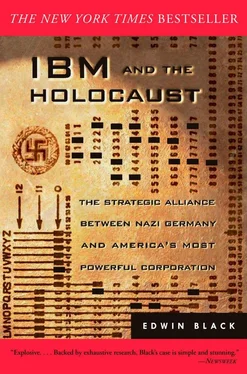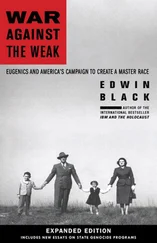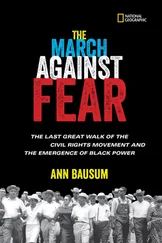A continuous “Speed Punching” operation ran two shifts, and three when needed. Each shift spanned 7.5 hours with 60 minutes allotted for “fresh air breaks” and a company-provided meal. Day and night, Dehomag staffers entered the details on 41 million Prussians at a rate of 150 cards per hour. Allowing for holidays and a statistical prediction of absenteeism, yet ever obsessed with its four-month deadline, Dehomag decreed a quota of 450,000 cards per day for its workforce. Free coffee was provided to keep people awake. A gymnast was brought in to demonstrate graceful aerobics and other techniques to relieve fatigue. Company officials bragged that the 41 million processed cards, if stacked, would tower two and a half times higher than the Zugspitze, Germany’s 10,000-foot mountain peak. Dehomag intended to reach the summit on time. 21
As company officials looked down upon a floor plan of the layout, the linear rows and intersecting columns of work stations must have surely resembled a grandiose punch card itself animated into a three-dimensional bricks and mortar reality. Indeed, a company poster produced for the project showed throngs of miniscule people scrambling over a punch card sketch. 22The surreal artwork was more than symbolic.
Once punched, the columns were imbued with personal information about the individual: county, community, gender, age, religion, mother tongue, number of children, current occupation, and second job, if any. 23
“Be Aware!” reminded huge block-lettered signs facing each cluster of data entry clerks. Instructions were made clear and simple. Column 22 RELIGION was to be punched at hole 1 for Protestant, hole 2 for Catholic, or hole 3 for Jew. Columns 23 and 24 NATIONALITY were to be coded in row 10 for Polish speakers. 24
After punching, the cards were shuttled to a separate section of the hall, where they passed through long, squat Hollerith counters at the rate of 24,000 per hour. The system kept track of its own progress. Hence, Dehomag was always aware whether it was on schedule. Once counted, the cards moved to the proofing section. No errors would be tolerated and speed was essential. Proofing machines tabulated and verified proper punching for more than 15,000 cards per hour. 25
When Jews were discovered within the population, a special “Jewish counting card” recorded the place of birth. These Jewish counting cards were processed separately. 26
Then came the awesome sorting and resorting process for twenty-five categories of information cross-indexed and filtered through as many as thirty-five separate operations—by profession, by residence, by national origin, and a myriad of other traits. It was all to be correlated with information from land registers, community lists, and church authorities to create a fantastic new database. What emerged was a profession-by-profession, city-by-city, and indeed a block-by-block revelation of the Jewish presence. 27
A Reich Statistical Office summary reported: “The largest concentration of Jews [in Berlin] will be found in the Wilmersdorf district. Approximately 26,000 Observant Jews account for 13.54 percent of the population within that district.” Further: a total of 1,200 “Fur-Jews” accounted for 5.28 percent of the furrier trade, and nearly three-fourths of those are foreign-born. Further: based on existing emigration trends triggered by anti-Jewish persecution “only 415,000 to 425,000 Faith-Jews would remain in the German Reich by the middle of 1936.” 28
Dehomag’s precious information would now help propel a burgeoning new binary of pseudo-science and official race hatred. Racial hygiene, race politics, and a constellation of related anti-Semitic disciplines were just so much talk in the absence of genuine statistics. Now a lightning storm of anti-Jewish legislation and decrees restricting Jews from all phases of academic, professional, governmental, and commercial life would be empowered by the ability to target the Jews by individual name. Moreover, by cross-sorting the Jews revealed in Column 22 row 3 with Polish speakers identified in Columns 26 and 27 row 10, the Reich was able to identify who among the Jews would be its first targets for confiscation, arrest, imprisonment, and ultimately expulsion. The so-called OstJuden, or Eastern Jews, primarily from Poland, would be the first to go. 29
Friedrich Zahn, publisher of Allgemeines Statistisches Archiv, summed up the glee when he wrote, “In using statistics, the government now has the road map to switch from knowledge to deeds.” 30
* * *
DEHOMAG’S CENSUSundertaking was an unparalleled accomplishment for IBM. Watson was impressed from the moment Karl Koch secured the contract. Clearly, there was a lucrative future for IBM in Nazi Germany. At a time when other foreign companies were fleeing the Reich’s violence, repression, anti-Semitism, and the inability to retrieve income from German operations, Watson moved swiftly to dramatically enlarge IBM’s presence.
First, he ordered the merger of several small IBM subsidiaries in Germany. Optima, Degemag, Holgemag, as well as the existing Dehomag, were folded into a new corporation also to be named “Dehomag.” Through a cunning twirl of losses and profits among the four German companies, and then manipulating balances owed by those subsidiaries to IBM NY for so-called “loans,” Reich profit taxes would be avoided, despite record earnings in Germany. IBM NY would simply apply the incomes to the contrived loans it had extended to its own subsidiaries. IBM’s Maryland division was used as a con-duit for the loan transactions. A report from IBM’s accountants to the corporate treasurer was explicit: “the motive for the merger was to effect an annual savings in taxes by reducing Dehomag’s net profits by the amount of the net losses of Optima and [old] Dehomag… about $30,000 annually.” 31
Heidinger confirmed in a special report to Watson, “As the merger of Degemag, [old] Dehomag, and Optima is effected… corporation profits tax is out of the question… on account of the relief from [loan] claims of IBM, as thereby no profit, but merely a reduction of losses, is obtained.” 32
Second, IBM increased its investment in Dehomag from a mere RM 400,000 to more than RM 7 million—about a million Depression-era American dollars. This would include a million Reichsmarks to purchase new land in Berlin and build IBM’s first German factory. IBM was tooling up for what it correctly saw as a massive economic relationship with the Hitler regime. In the midst of America’s Depression, this expansion of manufacturing base would not relieve unemployment in the United States, but actually transfer American jobs to Nazi Germany where the Hollerith machines would be manufactured. 33
Understandably, Watson decided to visit Germany to observe conditions first hand, which he did on October 13, 1933. Despite a highly publicized boycott against German ocean liners, he ignored picket lines and sailed on the German ship Bremen. 34
Watson was impressed with what he saw in Berlin. The Watsons and the Heidingers managed many happy social moments together. Mrs. Watson even asked Heidinger for a copy of his portrait as a memento of their joyous time. Heidinger sent two. 35
Watson also visited the massive census operation at Alexanderplatz. There among the rows of data clicking clerks arrayed before their large block- letter instructions to enter Jews in Column 22 row 3, amid the clatter of shiny, black sorters flickering punch cards into a blur, Watson was moved to donate money to buy meals for everyone at IBM expense. As an added gesture, he authorized Dresden pastries for each and every member of the Statistical Office’s Census Department. Heidinger later wrote to Watson that the total bill for his “bountiful gift” of 6,060 meals disbursed to 900 staffers came in at just under 4,000 Reichsmarks. 36
Читать дальше












